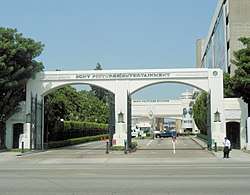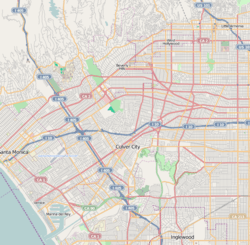Sony Pictures Studios
The Sony Pictures Studios is an American television and film studio complex located in Culver City, California at 10202 West Washington Boulevard and bounded by Culver Boulevard (south), Washington Boulevard (north), Overland Avenue (west) and Madison Avenue (east). Founded in 1912, the facility is currently owned by Sony Pictures Entertainment and houses the division's film studios, such as Columbia Pictures, TriStar Pictures, and Screen Gems. The complex was the original studios of Metro-Goldwyn-Mayer from 1924 to 1986 and Lorimar-Telepictures from 1986 to 1989.
| Sony Pictures Studios | |
|---|---|
 Overland Gate / West entrance – the entrance to Sony Pictures Studios | |
 Location within Western Los Angeles | |
| Former names |
|
| General information | |
| Type | Film and television studios |
| Location | Culver City, California, United States |
| Address | 10202 West Washington Boulevard |
| Coordinates | 34.017222°N 118.401667°W |
| Current tenants | Columbia Pictures TriStar Pictures Screen Gems Sony Pictures Animation Destination Films Sony Pictures Imageworks Stage 6 Films Affirm Films Sony Pictures Worldwide Acquisitions Sony Pictures Home Entertainment Sony Pictures Television TriStar Television Ghost Corps Happy Madison Productions |
| Inaugurated | 1912 as Inceville |
| Owner | Sony Pictures Entertainment(Sony) |
In addition to films shot at the facility, several television shows have been broadcast live or taped there. The lot, which is open to the public for daily studio tours, currently houses a total of sixteen separate sound stages.
Early history (1912-1924)

Director Thomas H. Ince built his pioneering Inceville studios in Pacific Palisades in 1912. While Ince was filming at Ballona Creek in 1915, Harry Culver, the founding father of Culver City, persuaded Ince to move Inceville to Culver City. During that time, Ince co-founded Triangle Film Corporation and the Triangle Studios was opened in the form of a Greek colonnade – the entrance to the studios. The colonnade still stands fronting Washington Boulevard and is a Culver City historical landmark.
Ince added a few stages and an Administration Building before selling out to his partners D.W. Griffith and Mack Sennett. Ince relocated down the street and built the Culver Studios at that location. In 1918, Triangle Studios was sold to film producer Samuel Goldwyn. Goldwyn also added a few sound stages before selling his shares in Goldwyn Studios.
The Historic MGM Studios/Lorimar-Telepictures Studios/Lorimar Studios (1924-1990)

In 1924, Loews Theatres President Marcus Loew organized the merger of three film companies – The Metro Pictures Corporation, Goldwyn Pictures and Louis B. Mayer Productions to form Metro-Goldwyn-Mayer and occupying the Goldwyn production facilities.
In the Golden Age of Hollywood, MGM Studios was responsible for shooting 52 films a year, from screen epics such as Ben-Hur, and Mutiny on the Bounty, to drawing-room dramas such as Grand Hotel, Dinner At Eight, and Anna Karenina. But it was the Technicolor musicals, including The Wizard of Oz, Singin' in the Rain and Gigi that MGM was best known for. MGM’s success led to six working studio complexes, more than 180 acres (0.73 km2) including twenty-eight soundstages – Stage 15 is the second largest sound stage in the world, and Stage 27 served as "Munchkinland" in the production of The Wizard of Oz.
In addition to the main production building, MGM added two large backlot facilities – Lot 2 located opposite the main studio across Overland Avenue. Lot 3 entered the corner of Jefferson Boulevard and Overland Avenue and was MGM’s largest backlot. The administration building was inaugurated in 1938 and was named for Thalberg.
However, the United States v. Paramount Pictures, Inc. antitrust case of 1948 severed MGM's connection with Loews Theaters, and it struggled through its affairs. In 1969, millionaire Kirk Kerkorian bought MGM and proceeded to dismantle the studio. MGM’s film memorabilia was sold through an 18-day auction, and 38 acres (150,000 m2) of the studio’s backlots were sold. Lot 3 was razed while Lot 2 was sold to housing developments. Kerkorian used the money to construct his hotel chain, the MGM Grand Hotels.
In 1981, Kerkorian's Tracinda Corporation acquired United Artists and merged it with Metro-Goldwyn-Mayer to become MGM/UA Entertainment Co. He then sold MUEC to Ted Turner in 1986, who after 74 days, sold MGM/UA back to Kerkorian while retaining the pre-1986 MGM film library. In 1986, the studio lot was sold to Lorimar-Telepictures. During that time, the MGM logo was removed from the studios and moved across the street to the Filmland Building (now known as Sony Pictures Plaza) before their 1992 move to Santa Monica and Century City and finally settling in Beverly Hills.[1]
Columbia Studios/Sony Pictures Studios (1990-present)
In early 1989, Warner Communications acquired Lorimar-Telepictures. Later that year, Sony hired producers Jon Peters and Peter Guber to run the company's newly acquired Columbia Pictures Entertainment unit, even though they had a contract with Warner Bros. To resolve this issue, Warner sold their Lorimar lot to Columbia, among other deals. Columbia had been sharing with Warner Bros. their studio lot in Burbank in a partnership called the Burbank Studios beginning in 1972. Sony sold its interest in the Burbank Studios as a result of the Guber-Peters issue.[2]
Sony acquired the property, first renamed Columbia Studios, in poor condition and thereafter invested $100 million to renovate the studio complex. The property underwent a three-year comprehensive plan as it transitioned to the 45 acres (0.18 km2) Sony Pictures Studios complex. The buildings, many of which still bore the names of MGM film luminaries such as Clark Gable, Judy Garland, Rita Hayworth and Burt Lancaster, were painted and upgraded. New walls were erected around the lot and the ironwork gates were restored. Nostalgic art deco and false fronts on Main Street were added, as well as hand-painted murals of Columbia film posters. The MGM logo was removed from the Filmland Building in late 1992.
The studio continues to record TV shows such as The Goldbergs, Ray Donovan, and Shark Tank. The long-running game shows Jeopardy! and Wheel of Fortune and its spin-offs are also taped at Sony Pictures Studios. The revival of American Gladiators produced by MGM Television was also taped there.
Taped programs
Talk shows
- Donny & Marie (1998–2000)
- The Queen Latifah Show (2013–2015)
- Chelsea (2016–2017)
Game shows
- Wheel of Fortune (1995–present)
- Jeopardy! (1994–present)
- Wheel 2000 (1997–1998)
- Jep! (1998–1999)
- Rock & Roll Jeopardy! (1998–2001)
- Pyramid (2002–2004)
- Russian Roulette (2002–2003)
- American Gladiators (2008 revival, Season 1 only)
- Sports Jeopardy! (2015–2016)
- The Joker's Wild (2017–present)
Sitcoms
- Cavemen (2007)
- The King of Queens (1998–2007)
- Living With Fran (2005–2006)
- Married... with Children (1994–1997)
- That's My Bush! (2001)
- Rules of Engagement (2007–2013)
- 'Til Death (2006–2010)
- The Goldbergs (2013–present)
- Dr. Ken (2015–2017)
- One Day at a Time (2017–present)
- Live in Front of a Studio Audience: Norman Lear's All in the Family and The Jeffersons (2019 special event)
Dramas
- Close to Home (2005–2007)
- The Guardian (2001–2004)
- Joan of Arcadia (2003–2005)
- Las Vegas (2003–2008)
- Party of Five (1994–2000)
- Masters of Sex (2013–2016)
- Ray Donovan (2013–2020)
- Insecure (2016–present)
Reality
- Shark Tank (2014–present)
- The Gong Show (2017–2018)
References
- Brennan, Judy; Brennan, Judy (1992-11-16). "MGM out, Sony in at Filmland". Variety. Retrieved 2020-03-05.
- Warner, Sony settle suit over producers (November 17, 1989). Los Angeles: Associated Press.
